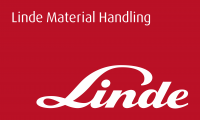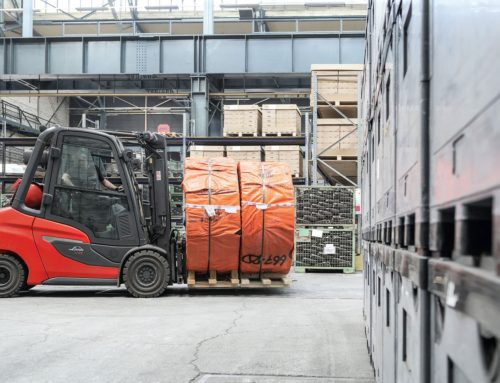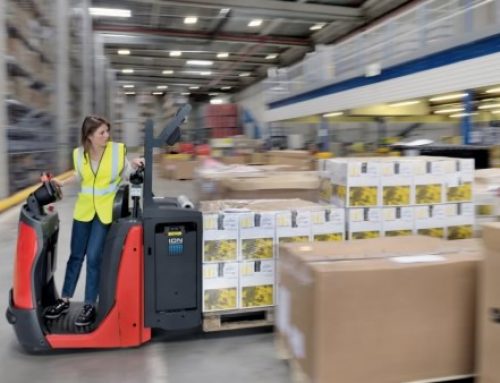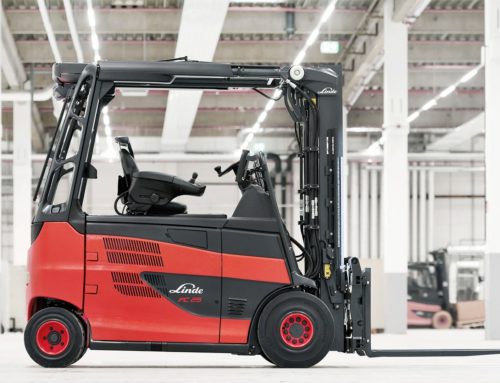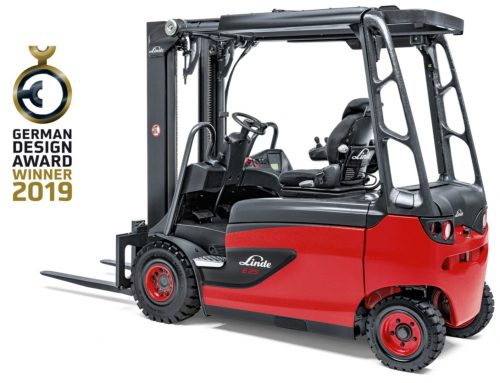The year is 1971: John Lennon releases the anthem Imagine and Ray Tomlinson sends the first e-mail in history. In the same year, Linde presents its first electrically driven forklift truck, the E10 – E15, at the Hanover Fair. Imagine becomes an immortal hit, e-mail the number one communication medium. And Linde’s electric forklifts also have a stellar career. Originally conceived merely as an exhaust-free alternative to the diesel-powered forklift for indoor use, the electric forklift soon becomes an important component of modern intralogistics and Linde Material Handling the market leader in this segment.
ELECTRIC FORKLIFTS: STEP BY STEP TO PERFECTION

Electric forklift E12 – E18 from 1982
After 1971, the once niche product electric forklift truck is gaining in importance quite fast. The main reason for this is the growing number of large warehouses and logistics centers. The steadily increasing turnover of goods at these new hubs calls for better trucks for indoor use that are both extremely maneuverable and can be operated with precision. At the same time, technical innovations are helping to narrow the performance gap to conventional combustion engine trucks bit by bit. In terms of payload, lifting speed and handling performance, the e-models are coming ever closer to their IC engine counterparts.
From the very beginning, Linde’s aim in developing the modern electric forklift truck has been to keep perfecting the vehicles. In the first step, this primarily means optimizing them for indoor use thanks to increasing precision and maneuverability. For this reason, the first models are already equipped with a two-motor front-wheel drive system, in which two electric motors are installed on the drive axle. With their help, the vehicles are able to turn exactly in the middle of the drive axle. At the beginning of the 1980s, the Aschaffenburg company also introduced power electronics, thanks to which electric motors can be controlled much more precisely.

E48 electric forklift from 1995
In 1994, the first four-wheeled Linde electric forklifts are equipped with the innovative combi-steering axle. It enables the vehicles to turn on the spot and within the vehicle contours. Just one year later, Linde Load Control is launched, enabling sensitive operation of the lift mast functions via joystick – a feature that quickly establishes itself as an industry standard. In 1999, Linde adds the first model with a three-phase or asynchronous motor to its product portfolio. For this new drive, the engineers develop custom power and control modules that combine the advantages of higher performance with high reliability and demanding outdoor applications. Small and maintenance-free, the two traction motors together with the lifting hydraulics and all control parts can be combined into one component – the compact drive axle.
Another milestone in 2002 was the switch to three-phase AC motors, which put Linde electric forklifts on a par with IC engine-powered forklifts in many performance areas.

1971: The starting gun
The E10 – E15 is the first Linde e-truck to hit the market. Its most prominent features: Dual-motor front-wheel drive, dual-pedal control and central control lever. In addition, the E10 – E15 already automatically reduces speed when cornering, which is today the absolute industry standard.

1982: Maximum comfort
Linde is also constantly improving the comfort of its electric forklifts. For the first time, the E12 – E18 offers an ergonomically optimized driver’s workplace, where the seat and steering column can be perfectly adjusted to the driver.

1994: Optimum maneuverability
With the E20 – E30, Linde is introducing two pioneering innovations at once: The new combi-steering axle also allows 4-wheel forklifts to turn on the spot, which significantly improves the maneuverability of the vehicles. At the same time, the new tilt cabin simplifies access to important vehicle parts, especially the battery.

1995: Full control
From the E14 – E20 series, Linde Load Control enables electric control of the lift mast functions via joystick. Thanks to its sensitive operation, the new technology is quickly becoming an industry standard and will soon be introduced on Linde’s diesel and gas powered forklifts as well.
ELECTRIC INNOVATIONS: ENERGY ON BOARD
In the new millennium, Linde rises to become the market leader in Europe for electric forklifts with the E20 – E50 series and continues to drive forward the technological development of its E-models. As early as 2000, the classic lead-acid battery can be replaced by a hydrogen fuel cell, which is now offered as a series option for all Linde E-trucks.
As early as 2006, Linde followed suit and presented the next E-sensation with an onboard charger and the compact drive axle. To charge, the truck now only needs to be connected to the appropriate socket via a charging cable. The charging power is automatically adapted to the respective battery type.

Electric forklift truck E50 from 2011
The onboard charger from Linde is a world first. In addition, Linde is making a name for itself with lithium-ion drives and impresses with the best safety concept and optimum integration of vehicle and LI-ION battery in this innovative technology.
With the 2- to 5-ton models, Linde is introducing further features to the market in 2010: for example, the vibration-decoupled drive axle, the automatically engaging handbrake, the digital battery charge indicator and a traction control system for best ground grip.
Linde makes E like no other
Linde also demonstrates its E-expertise in other areas: the E1 electric kart, developed on the basis of original E20 – E50 components, sets the acceleration world record for electrically powered karts in 2011 – with 3.45 seconds from 0 to 100 km/h, it drives straight into the Guinness Book of Records.

THE FUTURE IS ELECTRIC
Nowadays, there is no way around the electric forklift. Increasing cost pressure, tight timelines and order peaks that are difficult to estimate make its permanent availability and flexible deployment indispensable. In addition, there is an urgent need for exhaust-free drive systems that enable sustainability-oriented intralogistics against the backdrop of the global climate crisis.
In terms of economy, safety and ecological responsibility, electric forklifts have long been the benchmark for the material flow of the future. Thanks to permanently increasing performance and innovative energy systems such as lithium-ion technology, they are increasingly capable of fully replacing internal combustion engine vehicles.

Linde already provided impressive proof of this in 2015 when it launched the E60 – E80, a powerful electric forklift for the payload range up to eight tons.
Today, Linde Material Handling can look back on a long and successful E-truck history. As market and innovation leaders, the E-experts from Aschaffenburg have set out not only to serve this market comprehensively, but also to continue revolutionizing it. In mid-2021, Linde Material Handling will therefore introduce a new generation of electric forklift trucks. Like their predecessors, they will once again set the standards in the industry – in ergonomics, efficiency, safety and connectivity.
Take a look at our range of forklifts for sale.
